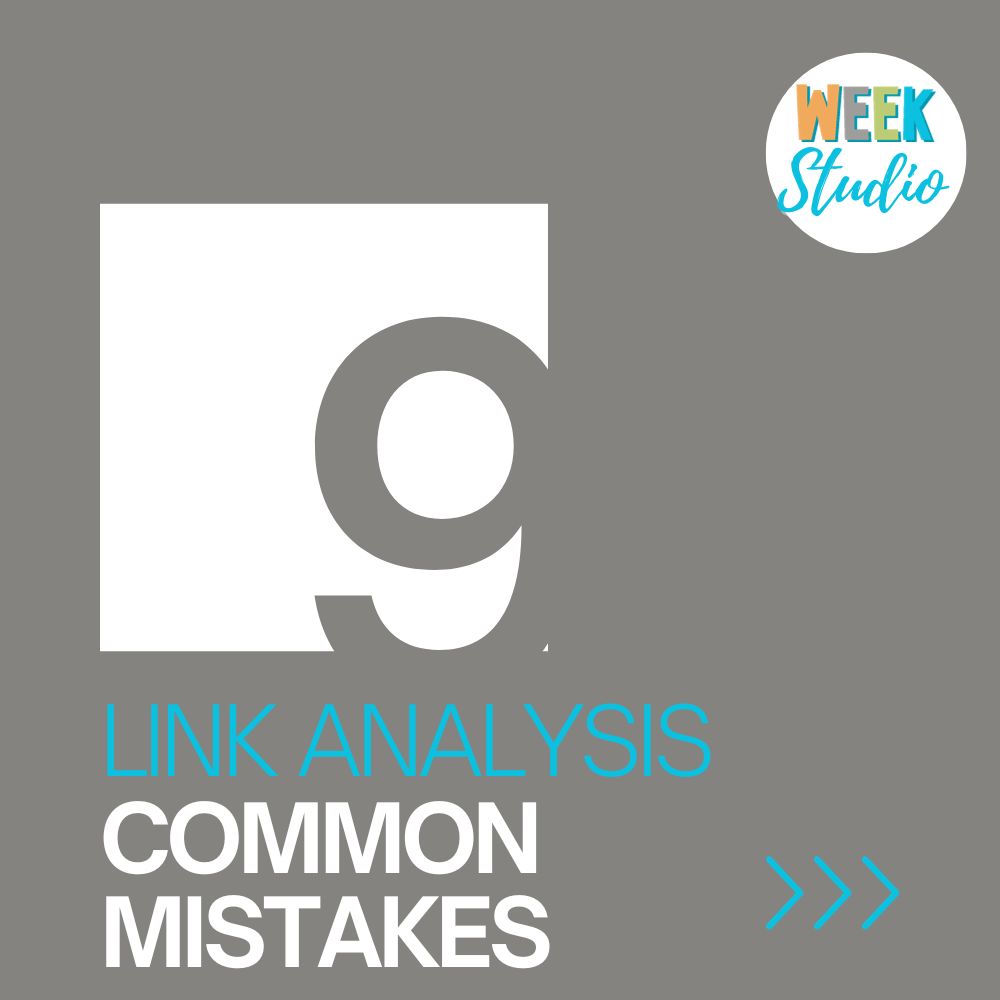In the dynamic world of SEO, one of the fundamental elements that can make or break your online visibility is link analysis. In the vast web of interconnected content, links serve as the threads binding the digital fabric together. This article delves into the crucial realm of link analysis, exploring its definition, importance, and its pivotal role in the intricate dance of search engine optimization (SEO).
Link analysis, in the context of SEO, refers to the assessment and evaluation of the links that connect various web pages. These links can be both internal, linking pages within the same website, or external, connecting pages from different domains. The analysis involves scrutinizing the quantity, quality, and relevance of these links to understand their impact on a website’s performance in search engine results.
Why does link analysis matter in the realm of SEO? The answer lies in the way search engines perceive and rank websites. Search engines view links as endorsements or votes of confidence. When a reputable website links to your content, it’s akin to receiving a virtual nod of approval. This endorsement signals to search engines that your content is valuable and relevant, thus influencing your website’s ranking.
In essence, link analysis helps search engines understand the credibility and authority of your website. The more high-quality links you have, the more likely it is that search engines will view your content as trustworthy and deserving of a higher position in search results.
As we journey deeper into the intricacies of link analysis, we’ll explore the types of links, strategies for building them, tools for analysis, common mistakes to avoid, and much more. So, buckle up as we navigate the labyrinth of link analysis, unraveling its mysteries and uncovering strategies for boosting your website’s SEO performance.
Types of Links

Understanding the diverse landscape of links is paramount in mastering link analysis. Links come in various forms, each playing a unique role in shaping a website’s online presence. Let’s delve into the three primary types of links: inbound links (backlinks), outbound links, and internal links.
Inbound Links (Backlinks)

- Definition: Inbound links, commonly known as backlinks, are links pointing from external websites to your site. Think of them as digital recommendations or citations from other online entities. The more reputable and relevant the source, the more impactful the backlink.
- Importance in Link Analysis: Search engines interpret backlinks as a vote of confidence in your content. Quality backlinks from authoritative websites can significantly enhance your site’s credibility and positively influence its search engine ranking.
Outbound Links
- Definition: Outbound links are links from your website to external sites. While not as directly influential as inbound links, outbound links play a role in establishing the context and relevance of your content.
- Importance in Link Analysis: Including relevant outbound links to reputable sources can enhance your content’s credibility. It demonstrates a commitment to providing valuable information and contributes to a healthy online ecosystem.
Internal Links
- Definition: Internal links connect different pages within the same website. These links facilitate navigation, guide users to related content, and distribute page authority throughout the site.
- Importance in Link Analysis: Internal links contribute to a cohesive website structure, allowing search engines to understand the hierarchy and relationships between pages. Strategic internal linking can enhance user experience and improve the overall SEO performance of your site.
As we navigate the intricate world of link analysis, keep in mind that a well-rounded SEO strategy involves a harmonious blend of these link types. The goal is not only to acquire high-quality backlinks but also to create a network of internal and outbound links that enrich the user experience and reinforce your website’s credibility. Now, let’s explore why the quality of these links matters and how they can significantly impact your website’s search engine ranking.
Significance of Quality Links

Now that we’ve uncovered the various types of links, let’s dive into why the quality of these links holds immense significance in the realm of SEO. The impact of links on search engine ranking goes beyond mere quantity; it hinges on the relevance, authority, and trustworthiness of the linked sources.
Impact on Search Engine Ranking
The quantity of links was once the primary metric for search engine ranking. However, as search algorithms evolve, the emphasis has shifted towards quality over quantity. A handful of high-quality, relevant links from authoritative sources can outweigh a multitude of low-quality links. Search engines, such as Google, now prioritize the contextual relevance and authority of the linking domains.
Relevance and Authority
Relevance: The context in which a link is placed matters. A backlink from a website in the same industry or niche carries more weight than one from an unrelated source. Search engines recognize and reward links that align with the content they point to.
Authority: The authority of the linking domain directly influences the impact of a link. Links from reputable and well-established websites are considered more valuable. Websites with higher domain authority pass on more SEO “juice” to the linked pages.
In essence, quality links act as digital endorsements, vouching for the credibility and relevance of your content. They signal to search engines that your website is a reliable source of information in a specific domain.
Building Trust and Credibility
Search engines aim to provide users with trustworthy and reliable information. When your website accumulates quality backlinks, it builds trust and credibility. Users are more likely to trust a site that is endorsed by other reputable entities, leading to increased organic traffic and improved conversion rates.
In the next sections, we’ll explore effective link-building strategies, tools for comprehensive link analysis, and common mistakes to avoid. Understanding these aspects is crucial for crafting a robust link profile that not only boosts your SEO but also solidifies your position as a reliable resource in the digital landscape. Let’s embark on the journey of building and analyzing links strategically.
Link Building Strategies

As we unravel the complexities of link analysis, it’s essential to explore actionable strategies for building a robust network of links. Effective link building involves a combination of creativity, outreach, and strategic planning. Here are some tried-and-true link building strategies that can elevate your website’s SEO game.
Guest Posting
Definition: Guest posting involves creating and publishing content on other websites within your industry or niche. In return, you typically get the opportunity to include a backlink to your site in the author bio or within the content.
Strategic Approach: Identify reputable websites that accept guest posts in your niche. Craft high-quality, informative articles that add value to the host site’s audience. Ensure that your author bio includes a compelling link back to your website.
Social Media Sharing
Definition: Leverage the power of social media platforms to share your content. When your content gets shared and linked to on social media, it can attract attention from influencers and other websites, leading to potential backlinks.
Strategic Approach: Actively share your content on platforms relevant to your audience. Engage with influencers and thought leaders in your industry by tagging them when sharing relevant content. Encourage your followers to share your posts, increasing the likelihood of organic backlinks.
Influencer Collaborations
Definition: Collaborate with influencers in your industry to create content. Influencers often have a significant following, and their endorsement can result in valuable backlinks and increased visibility.
Strategic Approach: Identify influencers whose audience aligns with your target demographic. Propose collaboration ideas that benefit both parties. This could include co-authored content, interviews, or joint social media campaigns. Ensure that the collaboration naturally incorporates links to your website.
Resource Link Building

Definition: Create valuable resources on your website, such as guides, infographics, or tools. Reach out to other websites and offer these resources for them to link to, positioning your content as a valuable reference.
Strategic Approach: Identify websites that could benefit from linking to your resources. Craft personalized outreach messages highlighting the value your content brings to their audience. Emphasize how linking to your resource enhances the quality of their content.
Broken Link Building
Definition: Identify broken links on other websites within your niche. Reach out to the website owners, notifying them of the broken link, and suggest replacing it with a link to relevant content on your site.
Strategic Approach: Use tools like Check My Links or Ahrefs to find broken links. Craft polite and helpful outreach messages, offering your content as a suitable replacement for the broken link.
Implementing a combination of these strategies can diversify your link profile and strengthen your website’s authority. In the next sections, we’ll explore tools for in-depth link analysis, common mistakes to avoid in your link-building endeavors, and the critical role of anchor texts in link optimization. Stay tuned as we navigate the intricate landscape of link building for SEO success.
Tools for Link Analysis

In the ever-evolving landscape of SEO, having the right tools at your disposal can make all the difference in comprehensively analyzing and optimizing your link profile. Let’s explore some powerful tools that provide valuable insights into your website’s link structure and help refine your link building strategy.
Google Search Console
Google Search Console is a free tool provided by Google that offers a wealth of information about your website’s performance in search results. It provides data on the number of backlinks, referring domains, and the keywords your site ranks for. Regularly monitor the “Links” section in Google Search Console to track the growth of your backlink profile. Identify high-performing pages and assess the overall health of your link portfolio.
Ahrefs
Ahrefs is a comprehensive SEO tool that excels in backlink analysis. It offers detailed insights into your backlink profile, including the number of backlinks, referring domains, and the authority of linking sites. Use Ahrefs to conduct competitor analysis, identify new link-building opportunities, and monitor the impact of your link-building efforts. The “Site Explorer” feature provides a detailed overview of your website’s backlink health.
Moz
Moz is another powerful tool for link analysis and domain authority measurement. It offers metrics such as Domain Authority (DA) and Page Authority (PA), which indicate the overall strength of your website and individual pages. Regularly check your website’s Domain Authority in Moz to gauge its overall SEO strength. Moz’s “Link Explorer” provides detailed insights into your backlink profile, helping you identify areas for improvement.
Why The Semrush is The Best

Semrush is a versatile SEO tool that covers various aspects of online visibility. Its backlink analytics feature provides information on referring domains, backlink types, and the authority of linking websites. Leverage Semrush to conduct in-depth backlink audits, track your website’s backlink growth over time, and identify potential toxic backlinks that may harm your SEO efforts.
Open Site Explorer by Moz
- Purpose: Open Site Explorer is a tool specifically designed for backlink analysis. It allows you to explore the backlink profile of any website, including your own or your competitors’.
- Utilization: Use Open Site Explorer to analyze the link-building strategies of competitors, identify authoritative websites in your niche, and uncover potential link-building opportunities.
These tools serve as invaluable companions in the journey of link analysis, enabling you to make informed decisions and fine-tune your link-building strategies. In the subsequent sections, we’ll explore common link analysis mistakes to avoid, the nuances of anchor texts, and the integral connection between link analysis and content quality. Stay tuned for insights that will enhance your SEO prowess.
Common Link Analysis Mistakes

While link building is a crucial component of SEO, it’s essential to tread carefully to avoid common pitfalls that can negatively impact your website’s performance. Let’s navigate through some prevalent link analysis mistakes that, when overlooked, can hinder your efforts to build a robust and effective link profile.
Ignoring Anchor Text Diversity
- Mistake: Overusing the same anchor text in your backlinks can raise red flags for search engines. Anchor text diversity is key to a natural and organic link profile.
- Solution: Vary your anchor text, incorporating a mix of branded terms, generic phrases, and relevant keywords. This not only improves the user experience but also signals to search engines that your link profile is natural and not manipulated.
Neglecting Link Relevance
- Mistake: Pursuing links from sites that are irrelevant to your content or industry can harm your SEO efforts. Search engines prioritize links that make contextual sense.
- Solution: Focus on acquiring links from websites that are closely related to your niche. Relevance enhances the perceived value of the link, signaling to search engines that your content is an authoritative source within its specific domain.
Overlooking Broken Links
- Mistake: Neglecting broken links on your website or within your backlink profile can negatively impact user experience and harm your SEO.
- Solution: Regularly conduct audits to identify and fix broken links on your site. Additionally, when engaging in broken link building, ensure that the replacement link you propose is functional and relevant to the content.
Prioritizing Quantity Over Quality
- Mistake: Chasing a high number of backlinks without considering their quality can lead to a spammy link profile, potentially resulting in search engine penalties.
- Solution: Emphasize the acquisition of high-quality, relevant backlinks over sheer quantity. A few authoritative and contextually relevant links carry more weight than numerous low-quality links.
Ignoring Link Velocity
- Mistake: Rapid and unnatural spikes in the acquisition of backlinks can raise suspicions with search engines, potentially leading to penalties.
- Solution: Aim for a steady and natural progression in acquiring backlinks. Sudden increases in link activity can be perceived as manipulative, so focus on consistency and gradual growth.
Neglecting Mobile-Friendly Links
- Mistake: In an era where mobile usage is predominant, neglecting the mobile-friendliness of your website and linked content can hinder user experience.
- Solution: Ensure that your linked pages are mobile-friendly and provide a seamless experience across various devices. Search engines prioritize mobile-first indexing, and mobile-friendly content is crucial for SEO success.
Avoiding these common mistakes is crucial for maintaining a healthy link profile and maximizing the positive impact of your link-building efforts. In the next sections, we’ll delve into the intricacies of anchor texts, the symbiotic relationship between link analysis and content quality, and explore how staying updated on evolving trends can give you a competitive edge in the dynamic world of SEO. Stay tuned for more insights.
Understanding Anchor Texts

In the intricate tapestry of link analysis, anchor texts play a pivotal role in conveying the context and relevance of a hyperlink. Crafting anchor texts strategically can significantly impact how search engines interpret the linked content and contribute to the overall effectiveness of your link-building efforts.
Importance of Anchor Texts in Link Analysis
Anchor texts provide search engines with valuable information about the content of the linked page. A well-crafted anchor text helps search engines understand the context and relevance of the linked content within the broader scope of the internet. Beyond their SEO implications, anchor texts contribute to a seamless user experience by providing users with a preview of what to expect when they click on a link, guiding them to content that aligns with their interests.
Best Practices for Anchor Text Optimization

Variety is crucial when it comes to anchor texts. Avoid using the same anchor text repeatedly, as it can be perceived as manipulative by search engines. Craft anchor texts using natural language that fits seamlessly into the surrounding content, steering clear of overly optimized or keyword-stuffed phrases. Ensure that the anchor text aligns with the content of the linked page to maintain contextually relevant links for both users and search engines.
Different Types of Anchor Texts
In the realm of anchor texts, diversity is key. Branded anchor texts, which incorporate your brand name, are important for reinforcing your brand’s online presence, especially when building links from authoritative sources. Exact match anchor texts, containing the target keyword, can be effective for SEO, but their usage should be judicious to avoid appearing overly optimized. Partial match anchor texts, with variations of the target keyword, offer a balanced approach, providing relevance without risking over-optimization.
Understanding and implementing best practices for anchor texts contribute to a more natural and effective link profile. As we delve deeper into link analysis, we’ll explore the intricate relationship between link quality and content, uncover evolving trends, and discuss key performance indicators for measuring link success.
Link Analysis and Content Quality
In the symbiotic relationship between link analysis and content quality, the two elements intertwine to form the backbone of a successful SEO strategy. The quality of your content not only influences the likelihood of acquiring high-quality backlinks but also determines the impact those links will have on your website’s search engine ranking. The content you produce serves as the foundation for attracting valuable backlinks. High-quality, informative, and engaging content naturally attracts links from authoritative sources. When other websites link to your content, they are essentially vouching for its credibility and usefulness.
To foster a robust link profile, focus on creating content that is inherently link-worthy. This involves understanding your target audience, addressing their needs, and providing unique insights or solutions. Content that stands out in terms of quality and relevance is more likely to attract organic backlinks. Consider where and how your content is positioned within your website. Ensure that important pages and articles are easily accessible, and strategically place internal links to guide users and search engines to essential content. A well-structured website with cohesive internal linking enhances the overall user experience and contributes to better link equity distribution.
Diversify your content by incorporating multimedia elements such as infographics, videos, and interactive tools. These types of content are not only more shareable but also increase the likelihood of earning backlinks. Websites often link to visually appealing and interactive content that adds value to their own articles or pages. Invest in creating evergreen content that remains relevant over time. While timely and trending content is valuable, having a solid foundation of evergreen content ensures a consistent influx of backlinks over the long term. This stability in link acquisition contributes to the overall health and authority of your website.
As we navigate the intricate interplay between link analysis and content quality, it becomes evident that one cannot thrive without the other. In the subsequent sections, we’ll explore the strategic aspects of link analysis for gaining a competitive advantage, delve into emerging trends shaping the future of link building, and discuss key performance indicators to measure the success of your link-building endeavors. Stay with us as we uncover the nuances of mastering link analysis in the dynamic landscape of SEO.
Link Analysis for Competitive Advantage
In the competitive arena of SEO, link analysis emerges as a powerful tool for gaining a strategic advantage. By dissecting the backlink profiles of competitors, you can uncover valuable insights, identify gaps in your own strategy, and strategically position your website for enhanced visibility.
Regularly analyze the backlink profiles of your competitors. Tools like Ahrefs and Moz can unveil the sources and types of links they have acquired. By understanding their link-building strategies, you gain valuable intelligence for refining your own approach.
Examine the quality of links your competitors have secured. Identify links from reputable and authoritative websites within your industry. These are potential targets for your own link-building efforts, allowing you to position your site as an equal or superior resource. Evaluate the content that attracts backlinks to your competitors’ sites. Identify topics or formats that resonate with your shared audience but are not yet covered on your website. Filling these content gaps can be a strategic move to attract similar or even better links.
If your competitors have successfully secured backlinks through specific strategies, consider emulating those approaches. Whether it’s through guest posting, collaborations, or content partnerships, understanding what works in your industry can guide your own link-building endeavors. Monitor your competitors’ link-building activities over time. Industries evolve, and so do effective strategies. By staying abreast of your competitors’ adjustments, you can adapt your own approach to align with emerging trends and changes in your niche.
In the realm of link analysis, leveraging insights from competitor strategies is not about imitation but strategic adaptation. It’s about understanding the landscape, identifying opportunities, and positioning your website as a formidable contender in the competitive SEO arena. As we delve deeper, we’ll explore emerging trends shaping the future of link building and discuss key performance indicators to measure the success of your link-building endeavors. Stay tuned for more insights into mastering the art of link analysis.
Evolving Trends in Link Analysis
In the ever-changing landscape of SEO, link analysis is witnessing dynamic trends that shape the way websites are ranked and perceived by search engines.
Mobile-First Indexing has become a pivotal factor. As more users shift to mobile devices, search engines prioritize websites with a mobile-friendly design. This extends to link analysis, where the mobile responsiveness of linked content is crucial for maintaining a positive user experience.
Voice Search is altering the way people interact with search engines. Link relevance is now assessed in the context of natural language queries. Crafting links that align with conversational search patterns enhances visibility in voice search results.
Video Content is gaining prominence. Search engines recognize the value of multimedia content, and video links are becoming influential. Incorporating video content into your strategy can open new avenues for attracting high-quality backlinks.
Adapting to these trends is essential for a forward-thinking link analysis strategy. As we explore the intricate dynamics between link analysis and content quality, we’ll delve deeper into measuring link success and discuss emerging technologies shaping the future of SEO. Stay tuned for more insights into mastering the art of link optimization.
Measuring Link Success
Effectively gauging the success of your link-building efforts is integral to refining your strategy and maximizing the impact on your website’s SEO. Several key performance indicators (KPIs) offer insights into the performance of your link profile. Monitoring the number of unique domains linking to your site provides a snapshot of your link profile’s breadth. A healthy mix of referring domains indicates a diverse and well-rounded link portfolio.
Assessing the authority of your website and individual pages helps gauge the strength of your link profile. Tools like Moz and Ahrefs provide numerical scores, reflecting the perceived credibility and influence of your site. Analyzing the diversity of anchor texts used in your backlinks is crucial. A natural link profile includes a variety of anchor texts, ranging from branded terms to relevant keywords. Overemphasis on one type can appear manipulative.
High-authority and contextually relevant links carry more weight in search engine algorithms. Tools like Ahrefs and Majestic can assist in assessing link quality. The ultimate goal of link building is not just to acquire links but to drive meaningful traffic and conversions. Monitor the traffic coming from your backlinks and track the conversion rates to understand their impact on your business goals. The rate at which your site acquires new backlinks, known as link velocity, should be consistent and natural. Sudden spikes may raise red flags with search engines, potentially affecting your website’s ranking.
Future of Link Analysis in SEO
The landscape of SEO is continually evolving, and the future of link analysis holds intriguing possibilities shaped by emerging technologies and evolving search engine algorithms.
- Machine Learning and AI Integration As search engines become more sophisticated, machine learning and artificial intelligence (AI) will play a pivotal role in link analysis. These technologies can enhance the understanding of context, relevance, and user intent, leading to more nuanced ranking algorithms.
- Contextual Link Analysis: The future of link analysis is moving towards a more contextual approach. Search engines will increasingly prioritize links embedded within contextually relevant content, ensuring that the linkage contributes meaningfully to the user’s understanding of the topic.
- User Experience as a Ranking Factor: User experience is poised to become an even more significant factor in link analysis. Search engines may increasingly consider metrics like bounce rate, time spent on page, and overall user engagement as indicators of the quality and relevance of linked content.
- Dynamic Link Building Strategies: The traditional approaches to link building are evolving. Dynamic strategies that adapt to algorithm changes, user behavior, and emerging trends will be essential. The focus will shift towards building relationships, creating value, and fostering genuine connections within the digital ecosystem.
- Ephemeral and Interactive Content Links: As the popularity of ephemeral content and interactive media rises, links embedded in formats like stories, quizzes, and interactive infographics may become more influential. This shift requires a flexible approach to link analysis that accommodates diverse content formats.
- Blockchain for Enhanced Transparency: The decentralized nature of blockchain technology holds the potential to bring transparency and credibility to link analysis. Blockchain can be utilized to verify the authenticity of backlinks, mitigating issues like link spam and black-hat SEO tactics.
Adapting to these trends will be crucial for staying ahead in the world of SEO. Link analysis will continue to be a cornerstone of effective search engine optimization, but its methodologies and considerations will evolve to meet the demands of a dynamic digital landscape. As we conclude our exploration of link analysis, let’s address some frequently asked questions to provide additional clarity on this intricate aspect of SEO.
Conclusion
In the ever-evolving realm of SEO, mastering the art of link analysis is a dynamic journey. From understanding the intricacies of different link types to crafting a diverse and natural link profile, the impact of link analysis on search engine ranking cannot be overstated. As we gaze into the future, the integration of machine learning, a focus on user experience, and innovative link-building strategies will shape the landscape of link analysis.
Remember, the essence of effective link building lies not only in quantity but, more importantly, in the quality, relevance, and context of the links you cultivate. Strategic adaptation to emerging trends and a commitment to providing value to your audience will be the cornerstones of a successful link analysis strategy.
Frequently Asked Questions (FAQs)
- Why is link analysis important for SEO? Link analysis is crucial for SEO because search engines view links as indicators of credibility, authority, and relevance. Analyzing and optimizing your link profile can significantly impact your website’s search engine ranking and visibility.
- What is the significance of anchor texts in link analysis? Anchor texts provide context to search engines about the linked content. Optimizing anchor texts involves using a natural mix of branded terms, generic phrases, and relevant keywords, contributing to a diverse and organic link profile.
- How do you measure link success in SEO? Key performance indicators for measuring link success include monitoring referring domains, assessing domain authority and page authority, analyzing anchor text diversity, evaluating link quality and relevance, and tracking traffic and conversion rates from backlinks.
- What are the emerging trends in link analysis? Emerging trends include the integration of machine learning and AI, a shift towards contextual link analysis, the increasing importance of user experience as a ranking factor, dynamic link building strategies, and the potential use of blockchain for enhanced transparency.
- How can I adapt my link-building strategy to future trends? To adapt to future trends, focus on creating contextually relevant and valuable content, prioritize user experience, stay informed about algorithm changes, and embrace dynamic link-building strategies that align with emerging technologies and user preferences.
